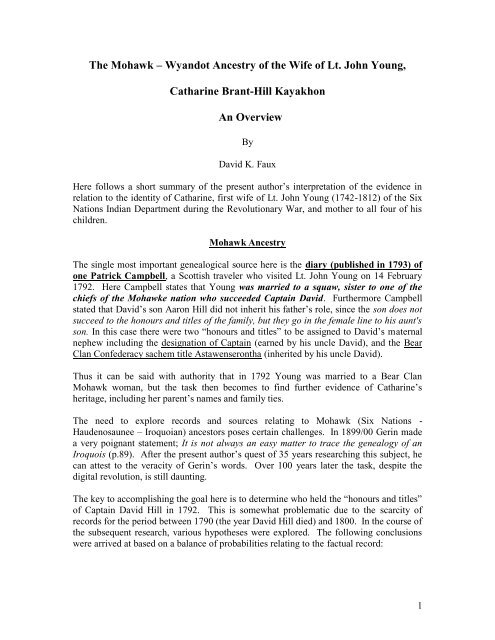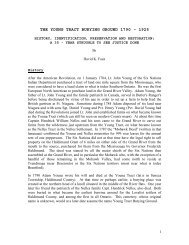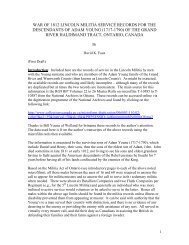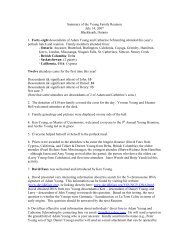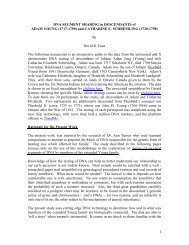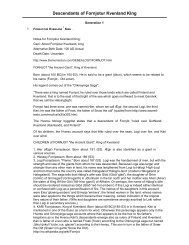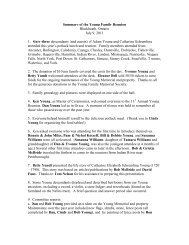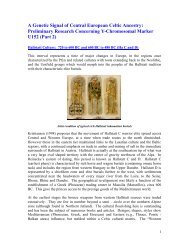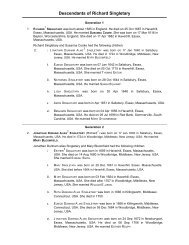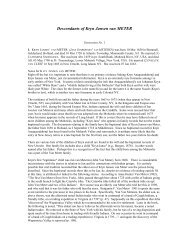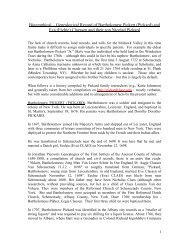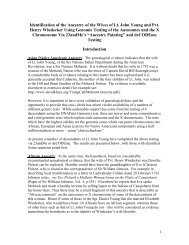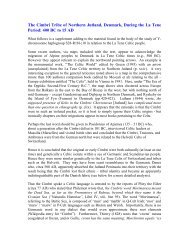The Mohawk â Wyandot Ancestry of the Wife of Lt ... - Davidkfaux.org
The Mohawk â Wyandot Ancestry of the Wife of Lt ... - Davidkfaux.org
The Mohawk â Wyandot Ancestry of the Wife of Lt ... - Davidkfaux.org
You also want an ePaper? Increase the reach of your titles
YUMPU automatically turns print PDFs into web optimized ePapers that Google loves.
<strong>The</strong> <strong>Mohawk</strong> – <strong>Wyandot</strong> <strong>Ancestry</strong> <strong>of</strong> <strong>the</strong> <strong>Wife</strong> <strong>of</strong> <strong>Lt</strong>. John Young,Catharine Brant-Hill KayakhonAn OverviewByDavid K. FauxHere follows a short summary <strong>of</strong> <strong>the</strong> present author’s interpretation <strong>of</strong> <strong>the</strong> evidence inrelation to <strong>the</strong> identity <strong>of</strong> Catharine, first wife <strong>of</strong> <strong>Lt</strong>. John Young (1742-1812) <strong>of</strong> <strong>the</strong> SixNations Indian Department during <strong>the</strong> Revolutionary War, and mo<strong>the</strong>r to all four <strong>of</strong> hischildren.<strong>Mohawk</strong> <strong>Ancestry</strong><strong>The</strong> single most important genealogical source here is <strong>the</strong> diary (published in 1793) <strong>of</strong>one Patrick Campbell, a Scottish traveler who visited <strong>Lt</strong>. John Young on 14 February1792. Here Campbell states that Young was married to a squaw, sister to one <strong>of</strong> <strong>the</strong>chiefs <strong>of</strong> <strong>the</strong> <strong>Mohawk</strong>e nation who succeeded Captain David. Fur<strong>the</strong>rmore Campbellstated that David’s son Aaron Hill did not inherit his fa<strong>the</strong>r’s role, since <strong>the</strong> son does notsucceed to <strong>the</strong> honours and titles <strong>of</strong> <strong>the</strong> family, but <strong>the</strong>y go in <strong>the</strong> female line to his aunt'sson. In this case <strong>the</strong>re were two “honours and titles” to be assigned to David’s maternalnephew including <strong>the</strong> designation <strong>of</strong> Captain (earned by his uncle David), and <strong>the</strong> BearClan Confederacy sachem title Astawenserontha (inherited by his uncle David).Thus it can be said with authority that in 1792 Young was married to a Bear Clan<strong>Mohawk</strong> woman, but <strong>the</strong> task <strong>the</strong>n becomes to find fur<strong>the</strong>r evidence <strong>of</strong> Catharine’sheritage, including her parent’s names and family ties.<strong>The</strong> need to explore records and sources relating to <strong>Mohawk</strong> (Six Nations -Haudenosaunee – Iroquoian) ancestors poses certain challenges. In 1899/00 Gerin madea very poignant statement; It is not always an easy matter to trace <strong>the</strong> genealogy <strong>of</strong> anIroquois (p.89). After <strong>the</strong> present author’s quest <strong>of</strong> 35 years researching this subject, hecan attest to <strong>the</strong> veracity <strong>of</strong> Gerin’s words. Over 100 years later <strong>the</strong> task, despite <strong>the</strong>digital revolution, is still daunting.<strong>The</strong> key to accomplishing <strong>the</strong> goal here is to determine who held <strong>the</strong> “honours and titles”<strong>of</strong> Captain David Hill in 1792. This is somewhat problematic due to <strong>the</strong> scarcity <strong>of</strong>records for <strong>the</strong> period between 1790 (<strong>the</strong> year David Hill died) and 1800. In <strong>the</strong> course <strong>of</strong><strong>the</strong> subsequent research, various hypo<strong>the</strong>ses were explored. <strong>The</strong> following conclusionswere arrived at based on a balance <strong>of</strong> probabilities relating to <strong>the</strong> factual record:1
<strong>Lt</strong>. John Young’s wife was Catharine Kayakhon, <strong>the</strong> adopted daughter <strong>of</strong> MargaretHill and Nichus Brant Canadiorha; and biological daughter <strong>of</strong> Mary KateriunighHill and an unknown European male, available evidence pointing to Sir WilliamJohnson. It is suspected that Catharine’s biological fa<strong>the</strong>r may have been European.Margaret and key members <strong>of</strong> her wider family belonged to <strong>the</strong> Lower <strong>Mohawk</strong> (Ft.Hunter) Bear Clan Astawenserontha family, but many resided at <strong>the</strong> Upper <strong>Mohawk</strong>Village (Canajoharie). In <strong>Mohawk</strong>, Kayakhon means, “She breaks / cuts all <strong>of</strong> <strong>the</strong>m”(Philip Henhawk, personal communication, 7 March 2011). Catharine was born in 1747,and baptized 3 June 1747 at <strong>the</strong> Schenectady Reformed Dutch Church. Catharine was anUpper <strong>Mohawk</strong> (Canajoharie) <strong>of</strong> Lower <strong>Mohawk</strong> ancestry. While it may be cogentlyargued that <strong>the</strong>re is only s<strong>of</strong>t evidence linking Catharine to Sir William Johnson, <strong>the</strong>re isevidence – and none whatsoever in relation to any o<strong>the</strong>r white man. Hence <strong>the</strong> attributionmust remain tentative for <strong>the</strong> present, and would be immeasurably enhanced by adescendant <strong>of</strong> for example Sir William Johnson’s son Sir John Johnson matching one ormore members <strong>of</strong> <strong>the</strong> Young family who descend from <strong>Lt</strong>. John Young and Catharine inautosomal genetic testing.<strong>The</strong> evidence emerging from <strong>the</strong> Campbell Diary shows that Catharine was a half sister<strong>of</strong> <strong>the</strong> <strong>Mohawk</strong> chief Seth Hill Kanenkaregowagh who succeeded to <strong>the</strong> title Confederacytitle Astawenserontha (Bear Clan Mo<strong>the</strong>r Mary Hill Kateriunigh).<strong>Wyandot</strong> <strong>Ancestry</strong>Based largely on evidence stemming from <strong>the</strong> obituary <strong>of</strong> Catharine’s grandsonWarner H. Nelles, it appears that Catharine was also <strong>of</strong> <strong>Wyandot</strong> descent or affiliation.It is recorded that her adopted fa<strong>the</strong>r Nicholas Brant was a member <strong>of</strong> <strong>the</strong> Beaver Clan /Tribe (one <strong>of</strong> <strong>the</strong> very few <strong>Mohawk</strong>s <strong>of</strong> record to hold to this affiliation which likelycame to <strong>the</strong> <strong>Mohawk</strong>s via Huron - <strong>Wyandot</strong> captives). However he was a member <strong>of</strong> <strong>the</strong>Bear Clan / Tribe, Astawenserontha family, and first cousin to Mary Hill.All indications are that sometime around <strong>the</strong> time <strong>of</strong> <strong>the</strong> War <strong>of</strong> 1812, a sachemshipbelonging to <strong>the</strong> Upper <strong>Mohawk</strong>s was created for <strong>the</strong> Huron – <strong>Wyandot</strong> faction at SixNations, apparently due to political turmoil and extreme factionalism at this time. <strong>The</strong>first to hold this principal sachem title belonging to <strong>the</strong> <strong>Mohawk</strong> Bear Clan(Astawenserontha family) was Francis Cotter Tahatonne. In 1817 Cotter left <strong>the</strong> SixNations Reserve with his entire family in order to join <strong>the</strong> <strong>Wyandot</strong>s <strong>of</strong> AnderdonTownship. It appears that since his was not a League sachem name, Cotter retainedTahatonne as his personal name. He moved to Anderdon Township Ontario, <strong>the</strong>nSandusky Ohio and ultimately Kansas. His children and grandchildren eventually movedto Oklahoma.In <strong>the</strong> above year (1817), Catharine’s grandson via her daughter Elizabeth, Warner H.Nelles, stepped into Cotter’s shoes and was made a chief in <strong>the</strong> “room” <strong>of</strong> <strong>the</strong> latter,likely using a Bear Clan name bestowed upon him for <strong>the</strong> occasion. <strong>The</strong> obituary <strong>of</strong>Nelles indicates that in 1817 (at age 17) he was appointed chief <strong>of</strong> <strong>the</strong> “Beaver Tribe” andin a formal ceremony <strong>of</strong> installation, using strings <strong>of</strong> wampum to represent his “horns <strong>of</strong>2
<strong>of</strong>fice”, Nelles was invested as a chief, his name being Tahanata. This is a <strong>Mohawk</strong>name meaning, “Towards his village” (Philip Henhawk, personal communication, 7March 2011).To view <strong>the</strong> complete and detailed (55 page) study, click here, <strong>the</strong>n on <strong>the</strong> button at <strong>the</strong>lower right.Genetic Test Evidence<strong>The</strong> results <strong>of</strong> <strong>the</strong> genomic testing (22 pairs <strong>of</strong> autosomes) <strong>of</strong> <strong>the</strong> descendants <strong>of</strong>Catharine has been very informative, and using <strong>the</strong> newest testing procedures, supports<strong>the</strong> genealogical evidence. Clearly she was highly admixed. It is well documented tha<strong>the</strong>r Hill ancestors were very admixed, but having a European fa<strong>the</strong>r would be consistentwith <strong>the</strong> evidence. Perhaps ultimately this work could, for example, pinpoint <strong>the</strong> regionin Nor<strong>the</strong>ast Asia where some <strong>of</strong> Catharine’s <strong>Mohawk</strong> ancestors originated manythousands <strong>of</strong> years ago. However for <strong>the</strong> perspective <strong>of</strong> <strong>the</strong> present work, it will tend tosupport one or more hypo<strong>the</strong>ses that can be linked to <strong>the</strong> paper trail. To view <strong>the</strong>manuscript on this subject, and this hypo<strong>the</strong>sis click here.Selection <strong>of</strong> Hill Family Records and Sources<strong>The</strong> Hills can be traced to <strong>the</strong> mid 1600s, admirable for genealogists working in Europelet alone on <strong>the</strong> frontier <strong>of</strong> <strong>the</strong> New World. <strong>The</strong> following items may be <strong>of</strong> interest toresearchers and family members. No matter which hypo<strong>the</strong>sis as to <strong>the</strong> ancestry <strong>of</strong>Catharine is accepted, <strong>the</strong> Hill family is included. <strong>The</strong> links below pertain primarily to<strong>the</strong> hypo<strong>the</strong>sis noted at <strong>the</strong> top <strong>of</strong> this manuscript:1) Genealogy: <strong>The</strong> individual files will not upload to this page. Please click on linkon <strong>the</strong> links at bottom right <strong>of</strong> author’s website at www.davidkfaux.<strong>org</strong>.2) Family Story: As above.3) Baptismal record <strong>of</strong> Catharine – click here4) Lower <strong>Mohawk</strong> Deed <strong>of</strong> 1789 signed by many in <strong>the</strong> family <strong>of</strong> Catharine clickhere5) Upper <strong>Mohawk</strong> Deed <strong>of</strong> 1789 signed by Kayakhon Katerin and her sundryrelatives from that community – click here6) Seth Newhouse list <strong>of</strong> women’s and warrior’s names associated with <strong>the</strong> BearClan Astawenserontha family (“loaned” prior to 1880 to <strong>the</strong> Dehennakarinehfamily) – click here7) Patrick Campbell Diary entry <strong>of</strong> 1792 pertaining to John Young’s wife – clickhere8) Ge<strong>org</strong>e Martin’s 1815 list <strong>of</strong> <strong>the</strong> “Principle Chiefs” <strong>of</strong> <strong>the</strong> <strong>Mohawk</strong>s includingAstawenserontha and <strong>the</strong> associated Tahatonne titles – click here. Catharine’sgrandson W.H. Nelles succeeded Francis Cotter to <strong>the</strong> latter in 1817.9) Painting <strong>of</strong> Catharine’s uncle Captain David Hill Karonghyontye with IndianDepartment <strong>of</strong>ficer Col. Guy Johnson in 1776 – click here. It should be noted that3
one might assume that <strong>Lt</strong>. John Young <strong>of</strong> <strong>the</strong> Indian Department may havesported a uniform similar to that <strong>of</strong> Johnson.10) Close up <strong>of</strong> <strong>the</strong> face <strong>of</strong> Captain David Hill from <strong>the</strong> above painting by BenjaminWest in 1776 – click here. Hill’s mixed European and <strong>Mohawk</strong> ancestry as notedby Campbell (see above), appears to be reflected in this depiction <strong>of</strong> his face.11) Photo <strong>of</strong> presentation pistol given to Captain David Hill by <strong>the</strong> Duke <strong>of</strong>Northumberland click here.12) Photo <strong>of</strong> <strong>the</strong> brass plate with Bear Clan etching from above pistol click here.13) Painting by Lewis Foy and sketch by Robert Pilkington <strong>of</strong> 1793 IndianConference at Buffalo Creek with Flying Sky (Karonghyontye) as orator clickhere.14) Photo <strong>of</strong> powder horn <strong>of</strong> Seth Kanenkaregowa (later Captain Seth HillAstawenserontha) click here.15) Sketch <strong>of</strong> engraving on above powder horn click here.As ever, my thanks to Thomas M. Nelson for his sage advice, guidance, constructivecriticism, and for digging up some materials that, despite diligent searching, had notcome to my attention.David K. Faux, Ph.D., C.Psych. (Retired)Caledonia Ontario CanadaCypress California USAVersion: 20 January 2012; Revised 22 December 2014.Copyright 2010-14. All rights reserved.4


